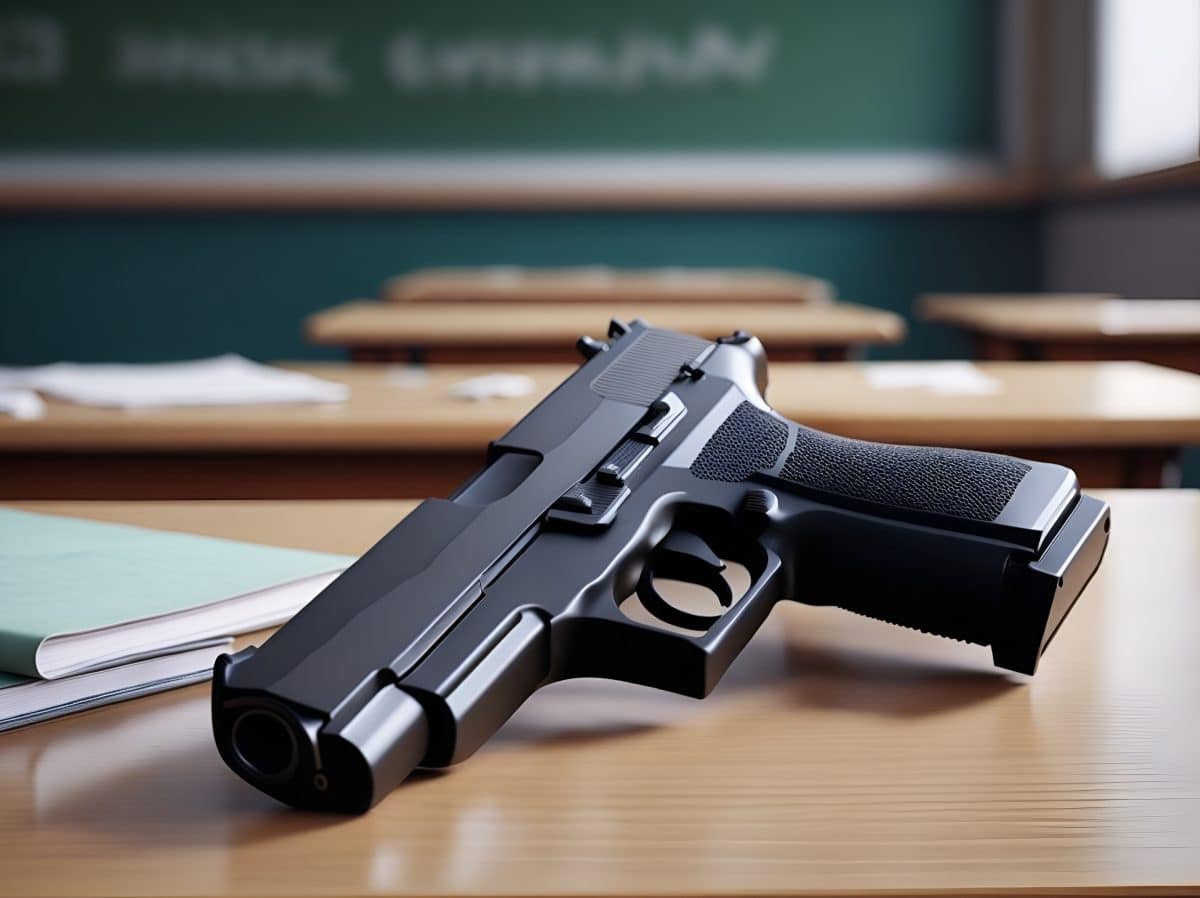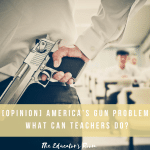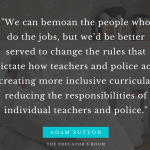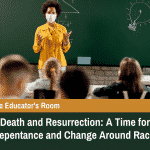Overview:
School shootings are traumatic. Here are six ways to have an impact on stopping them and bringing solutions that involve teachers.
Within twelve days, The Dallas-Fort Worth area has experienced two school shootings. The first shooting occurred at Wilmer-Hutchins High School in Dallas, Texas, on April 12, 2024. A teenage boy was shot in the leg by a 17-year-old, who sneaked a .38 revolver into the school, past several metal detectors. A Wilmer-Hutchins teacher’s courageous efforts were key in saving the injured student’s life. Now, Ja’Kerian Rhodes-Ewing has been arrested and charged with aggravated assault with a deadly weapon.
Fast forward to Wednesday, April 24th, when the staff and students at James Bowie High School in Arlington, Texas, were forced to go into lockdown mode. Seventeen-year-old Julian Howard, ran through the school shooting and killing an 18-year-old, peer, Etavian Barnes.
Two different communities…two different cities…same problem…GUNS!
I literally live five minutes from Wilmer-Hutchins High School. Many of the students I taught at Todd Middle School, attend school there. With so many connections to the school, it was heart-wrenching to watch horrified parents wait to learn the fate of their children. It brought me back to the many times I had to barricade and lock the classroom door, turn off the lights and sit with my students in silence, as we waited to see if a student who had access to a weapon would choose our classroom as the place to unleash their anger and frustration. School shootings are situations that are so severely traumatic it is almost impossible to put into words.
Teacher Trauma
Teachers are tired! Every day they leave their loved ones to enter schools to educate children, wondering what the day’s events might bring. Teachers are having to put their lives on the line, just because they chose a profession to empower children. Yet, there isn’t any real support for teachers in school communities that often experience this type of violent activity. They simply pick up where they left off and operate with a ‘business as usual’ mindset, when that is the most unhealthy and triggering approach. I can’t count how many times I left the school building still not fully aware of what transpired or the strategies we would use to prevent similar activity in the future. Further, I never had the opportunity speak to someone on campus to talk through my emotions and psychological needs.
Student Trauma
Students have experienced so much death that the fatalities of their peers have become mundane occurrences, leading to untraceable, deeply rooted traumas they don’t even know exist. School is supposed to be a safe haven for children and it is easily turning into a place where they hold candlelight vigils and release balloons to celebrate the lives of the peers they violently lost, usually at the hands of students they know. We cannot continue to ignore the emotional needs of students who experience continuous traumas. School leaders have to be vigilant in designing preventative measures that will curb violent activity and provide intentional emotional supports after incidences occur.
What the Data Says
The number of school shootings is significantly increasing every year. The K-12 School Shooting Database has recorded this information since 1966 (Riedman, David (2023).
“The data suggests there were at least 346 school shootings during 2023, surpassing the previous year’s 308 and 2021’s tally of 256.”
The K-12 School Shooting Database
As we analyze the numbers since 2020, we would be remiss not to make a correlation between the tremendous upsurge of school shootings and the psychological impacts of the COVID-19 pandemic on school-aged children. School systems have failed to provide the proper precautions to students after suffering such an unprecedented event, which caused millions of children to endure family members experience unexpected sickness, hospital stays, death, and isolation.
Students were ushered back into schools with the oblivious thought that social interaction was key, completely negating the necessity of social-emotional engagement and mental health wellness. The data shows that the very surface approach taken has caused a snowball effect on the mental wellness of students, which subsequently has led to an astronomical increase in violent acts on campuses across the country.
Six Changes for Real Impact
Convene a board of teachers to share their experiences and solutions to the issues!
Teachers are on the frontlines, yet they are the most silenced voices in education. Legislators aren’t experienced enough to make decisions for schools regarding safety. Their time would be better spent developing a Safe Schools Task Force that will allow teachers to develop safety plans that are based on preventative, not reactionary, measures.
Understand restorative practices are not enough!
Students cannot just be sent to meditation rooms to calm down and breathe when they are upset. For restorative practices to work effectively, students must understand the approach, its purpose, and its impact on behavior redirection. Most importantly, they must have a respectful connection with the restorative practitioner. Simply put, students must buy in to the system, or it will not work! School systems are creating restorative justice spaces but not identifying staff who can cultivate authentic relationships with students who struggle to manage their anger. The disconnect in the restorative practices approach will lead to the perpetuation of violent acts in schools if there isn’t an intentional redesign of the system.
Provide REAL wraparound services in disenfranchised communities!
Let’s be clear! A back-to-school festival with free backpacks, haircuts, and health screenings is not a real wraparound service. Students need continual access to physical and mental health practitioners, beginning in elementary school. If we are able to meet the needs of children early, we can provide them with the coping skills and strategies necessary to ensure their success throughout their educational journeys. These resources must also be available to parents and caretakers. If schools become community resource connectors that provide viable assistance to those in need, parents and students will feel more empowered to navigate challenging situations successfully.
Parents need to feel like school is a safe place for them as well. It should be a hub that provides access to information, resources, and training. Parents connected to the schools are more comfortable sharing issues they may have at home with their children. They are more engaged in exploring ways to approach and manage behaviors so the appropriate provisions can be taken early on. Also, they become more self-aware and begin to activate access to historically unavailable resources, as they relate to physical and mental health wellness.
Identify mental health practitioners who have lived experiences similar to the student population served!
Students are more likely to ask for help if their school provides mental health services. Too many times, students in disenfranchised communities do not have access to mental health professionals who truly understand their lived experiences and can relate to the trauma and mental anguish they’ve had to endure. School systems cannot continue to check boxes when it comes to mental health. There must be a reflective intentionality placed on developing an infrastructure that embraces diverse mental health practitioners in school communities.
This will ensure students feel safe in sharing their journeys and are open to learning new ways to process and express their feelings and emotions. Access to diverse mental health practitioners must also be provided continuously. School systems that have employed diverse mental health practitioners and provided the service repetitively have seen a tremendous decrease in students engaging in violent acts.
Train ALL school staff on mental health identifiers to encourage early intervention with students.
Hall monitors, security officers, and cafeteria staff are usually the first people to see students before the school day begins. Yet, they are never trained to identify students who may exhibit anger or frustration and are left unable to render aid to them, before the issues begin. Thus, sending them to classrooms where they normally unleash their rage on staff and peers who, in many situations, aren’t the root causes of their problems. If everyone on the campus has an understanding of how to determine students who may need to have the opportunity to collect themselves before going into communal spaces, it would greatly impede any physical violent acts that could occur.
Medal Detectors can’t be the only preventative measure!
School systems have to train teachers about the significance of building relationships with students. Many aggressive and violent attacks can be completely avoided if teachers are in tune with their students. The filing of bullying reports at schools across the nation are at an all-time high. The largest reason for the increase is that many teachers have absolved themselves of intervening in issues between students. Teachers who can mediate situations and hold students accountable for their wrongdoings are usually able to stop egregious incidences (like school shootings) from occurring before they start.
The key to the drastic reduction of school shootings is the teacher-student relationship and the innate ability of teachers to assess their students, identify when there is an issue and quickly disrupt the problem by facilitating wholesome conversations between the differing parties.






